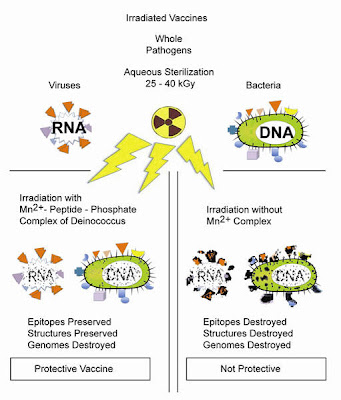Many different bacteria and viruses try to infect our bodies on a daily basis. Some are more deadly than others, and for various microbes we have found protection mechanisms by means of vaccines. However, we are currently unable to develop protecting vaccines for all infectious diseases, meaning that a lot of people still die from infections. A novel method developed by the Uniformed Services University of the Health Sciences works by using radiation to render microbes harmless, and can be used to make new vaccines. This should help us treat a variety of dangerous diseases.
Radiation
According to the scientists, their method is based on irradiating the microbe they want to develop a vaccine against. A bacterium or virus is treated with high doses of radiation, causing a lot of damage. This renders the microbe unable to assert any real harm to the body when infecting someone. Nevertheless, the immune system still recognizes the damaged bacteria or viruses and launches an attack. Because of the memory effect of the immune system, which forms the foundation for almost all vaccines, 'real' infections can consequently be dealt with much more effectively.
Resistance
Radiation is an effective tool to render microbes harmless, but the downside is it often also destroys proteins that the immune system uses to recognize the respective bacterium or virus. That means that administering these damaged microbes does not evoke a specific immune response, because these key 'marks', called epitopes, that are used to 'define' the infection are gone. Such vaccines would therefore not protect against a 'real' infection. Therefore, the scientists needed to find a way to render microbes harmless while keeping epitopes intact.
Tough
To keep the general structure of a microbe intact, the scientists turned to a bacterium called D. radiodurans. This bacterium is extremely resistant to radiation, as the name already reveals. It can withstand radiation levels that are 3000 times higher than what would be lethal for us human beings. By analysing this tough bacterium, the scientists found that it has high levels of an element called manganese (Mn), which binds to proteins inside the bacterial cell, and thereby protects them from damage during radiation. It works as an anti-oxidant and preserves epitopes during radiation treatment. It means that providing microbes with Mn can help to preserve protein structure, while other things, such as their genetic information, are destroyed.
Vaccines
Using Mn, the scientists showed that it is possible to damage microbes while keeping their epitopes intact, meaning they can be used in vaccines. With this method, scientists can develop vaccines with inactivated microbes, which used to be impossible due to epitope destruction. As a first attempt, the scientists showed that their method works in mice that were immunized for a drug-resistant version of S. aureus, a bacterium that can cause a variety of nasty infections. However, the scientists think their method can be used for many of the microbes, either bacterium, virus or fungus, that can be grown in the lab, and therefore are available for radiation treatment and vaccine generation.
Radiation
According to the scientists, their method is based on irradiating the microbe they want to develop a vaccine against. A bacterium or virus is treated with high doses of radiation, causing a lot of damage. This renders the microbe unable to assert any real harm to the body when infecting someone. Nevertheless, the immune system still recognizes the damaged bacteria or viruses and launches an attack. Because of the memory effect of the immune system, which forms the foundation for almost all vaccines, 'real' infections can consequently be dealt with much more effectively.
Resistance
Radiation is an effective tool to render microbes harmless, but the downside is it often also destroys proteins that the immune system uses to recognize the respective bacterium or virus. That means that administering these damaged microbes does not evoke a specific immune response, because these key 'marks', called epitopes, that are used to 'define' the infection are gone. Such vaccines would therefore not protect against a 'real' infection. Therefore, the scientists needed to find a way to render microbes harmless while keeping epitopes intact.
Tough
To keep the general structure of a microbe intact, the scientists turned to a bacterium called D. radiodurans. This bacterium is extremely resistant to radiation, as the name already reveals. It can withstand radiation levels that are 3000 times higher than what would be lethal for us human beings. By analysing this tough bacterium, the scientists found that it has high levels of an element called manganese (Mn), which binds to proteins inside the bacterial cell, and thereby protects them from damage during radiation. It works as an anti-oxidant and preserves epitopes during radiation treatment. It means that providing microbes with Mn can help to preserve protein structure, while other things, such as their genetic information, are destroyed.
 |
| Overview showing the effect of Mn during radiation. |
Using Mn, the scientists showed that it is possible to damage microbes while keeping their epitopes intact, meaning they can be used in vaccines. With this method, scientists can develop vaccines with inactivated microbes, which used to be impossible due to epitope destruction. As a first attempt, the scientists showed that their method works in mice that were immunized for a drug-resistant version of S. aureus, a bacterium that can cause a variety of nasty infections. However, the scientists think their method can be used for many of the microbes, either bacterium, virus or fungus, that can be grown in the lab, and therefore are available for radiation treatment and vaccine generation.


No comments:
Post a Comment